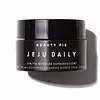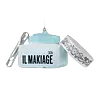What's inside
What's inside
 Key Ingredients
Key Ingredients

 Benefits
Benefits

 Concerns
Concerns

 Ingredients Side-by-side
Ingredients Side-by-side

Water
Skin ConditioningCyclopentasiloxane
EmollientCeresin
Emulsion StabilisingGlycerin
HumectantDimethicone
EmollientPEG-10 Dimethicone
Skin ConditioningPropanediol
SolventPanthenol
Skin ConditioningC12-15 Alkyl Benzoate
AntimicrobialSodium Chloride
MaskingSorbitan Olivate
EmulsifyingDisteardimonium Hectorite
StabilisingCetyl Alcohol
EmollientDistearyldimonium Chloride
Caprylyl Glycol
EmollientParfum
MaskingVolcanic Sand
Skin ConditioningLimonene
PerfumingEthylhexylglycerin
Skin ConditioningSilica
AbrasiveDisodium EDTA
Linalool
PerfumingSolanum Lycopersicum Leaf Cell Culture Extract
Skin ConditioningOpuntia Ficus-Indica Stem Extract
Skin ConditioningDaphne Odora Callus Extract
Skin ProtectingCitral
PerfumingHexyl Cinnamal
PerfumingOpuntia Ficus-Indica Callus Culture Extract
AntioxidantWater, Cyclopentasiloxane, Ceresin, Glycerin, Dimethicone, PEG-10 Dimethicone, Propanediol, Panthenol, C12-15 Alkyl Benzoate, Sodium Chloride, Sorbitan Olivate, Disteardimonium Hectorite, Cetyl Alcohol, Distearyldimonium Chloride, Caprylyl Glycol, Parfum, Volcanic Sand, Limonene, Ethylhexylglycerin, Silica, Disodium EDTA, Linalool, Solanum Lycopersicum Leaf Cell Culture Extract, Opuntia Ficus-Indica Stem Extract, Daphne Odora Callus Extract, Citral, Hexyl Cinnamal, Opuntia Ficus-Indica Callus Culture Extract
Water
Skin ConditioningGlycerin
HumectantDimethicone
EmollientCyclopentasiloxane
EmollientPropanediol
SolventVinyl Dimethicone/Methicone Silsesquioxane Crosspolymer
Polymethylsilsesquioxane
Dimethicone Crosspolymer
Emulsion StabilisingPEG-9 Polydimethylsiloxyethyl Dimethicone
EmulsifyingSodium Chloride
MaskingXylitylglucoside
HumectantHydroxyacetophenone
AntioxidantAnhydroxylitol
HumectantCaprylyl Glycol
EmollientXylitol
HumectantParfum
MaskingAdenosine
Skin ConditioningGlucose
HumectantDisodium EDTA
1,2-Hexanediol
Skin ConditioningSoluble Collagen
HumectantMagnesium Aluminum Silicate
AbsorbentCI 42090
Cosmetic ColorantPhaseolus Radiatus Seed Extract
Skin ConditioningCaprylic/Capric Triglyceride
MaskingHydrogenated Lecithin
EmulsifyingRetinol
Skin ConditioningPolyglyceryl-10 Myristate
Skin ConditioningTocopheryl Acetate
AntioxidantLinalool
PerfumingWater, Glycerin, Dimethicone, Cyclopentasiloxane, Propanediol, Vinyl Dimethicone/Methicone Silsesquioxane Crosspolymer, Polymethylsilsesquioxane, Dimethicone Crosspolymer, PEG-9 Polydimethylsiloxyethyl Dimethicone, Sodium Chloride, Xylitylglucoside, Hydroxyacetophenone, Anhydroxylitol, Caprylyl Glycol, Xylitol, Parfum, Adenosine, Glucose, Disodium EDTA, 1,2-Hexanediol, Soluble Collagen, Magnesium Aluminum Silicate, CI 42090, Phaseolus Radiatus Seed Extract, Caprylic/Capric Triglyceride, Hydrogenated Lecithin, Retinol, Polyglyceryl-10 Myristate, Tocopheryl Acetate, Linalool
 Reviews
Reviews

Ingredients Explained
These ingredients are found in both products.
Ingredients higher up in an ingredient list are typically present in a larger amount.
Caprylyl Glycol is a humectant and emollient, meaning it attracts and preserves moisture.
It is a common ingredient in many products, especially those designed to hydrate skin. The primary benefits are retaining moisture, skin softening, and promoting a healthy skin barrier.
Though Caprylyl Glycol is an alcohol derived from fatty acids, it is not the kind that can dry out skin.
This ingredient is also used as a preservative to extend the life of products. It has slight antimicrobial properties.
Learn more about Caprylyl GlycolCyclopentasiloxane, or D5, is a silicone used to improve texture of products and trap moisture.
D5 is considered lightweight and volatile. Volatile means it evaporates quickly after application. Once evaporated, D5 leaves a thin barrier that helps keep skin hydrated.
It is also an emollient. Emollients help soften the skin and prevent water loss. Silicones create a silky texture in products. D5 helps other ingredients become more spreadable.
Studies show D5 is safe to use in skincare products. We recommend speaking with a skincare professional if you have concerns.
Learn more about CyclopentasiloxaneDimethicone is a type of synthetic silicone created from natural materials such as quartz.
What it does:
Dimethicone comes in different viscosities:
Depending on the viscosity, dimethicone has different properties.
Ingredients lists don't always show which type is used, so we recommend reaching out to the brand if you have questions about the viscosity.
This ingredient is unlikely to cause irritation because it does not get absorbed into skin. However, people with silicone allergies should be careful about using this ingredient.
Note: Dimethicone may contribute to pilling. This is because it is not oil or water soluble, so pilling may occur when layered with products. When mixed with heavy oils in a formula, the outcome is also quite greasy.
Learn more about DimethiconeDisodium EDTA plays a role in making products more stable by aiding other preservatives.
It is a chelating agent, meaning it neutralizes metal ions that may be found in a product.
Disodium EDTA is a salt of edetic acid and is found to be safe in cosmetic ingredients.
Learn more about Disodium EDTAGlycerin is already naturally found in your skin. It helps moisturize and protect your skin.
A study from 2016 found glycerin to be more effective as a humectant than AHAs and hyaluronic acid.
As a humectant, it helps the skin stay hydrated by pulling moisture to your skin. The low molecular weight of glycerin allows it to pull moisture into the deeper layers of your skin.
Hydrated skin improves your skin barrier; Your skin barrier helps protect against irritants and bacteria.
Glycerin has also been found to have antimicrobial and antiviral properties. Due to these properties, glycerin is often used in wound and burn treatments.
In cosmetics, glycerin is usually derived from plants such as soybean or palm. However, it can also be sourced from animals, such as tallow or animal fat.
This ingredient is organic, colorless, odorless, and non-toxic.
Glycerin is the name for this ingredient in American English. British English uses Glycerol/Glycerine.
Learn more about GlycerinLinalool is a fragrance and helps add scent to products. It's derived from common plants such as cinnamon, mint, citrus, and lavender.
Like Limonene, this ingredient oxidizes when exposed to air. Oxidized linalool can cause allergies and skin sensitivity.
This ingredient has a scent that is floral, spicy tropical, and citrus-like.
Learn more about LinaloolParfum is a catch-all term for an ingredient or more that is used to give a scent to products.
Also called "fragrance", this ingredient can be a blend of hundreds of chemicals or plant oils. This means every product with "fragrance" or "parfum" in the ingredients list is a different mixture.
For instance, Habanolide is a proprietary trade name for a specific aroma chemical. When used as a fragrance ingredient in cosmetics, most aroma chemicals fall under the broad labeling category of “FRAGRANCE” or “PARFUM” according to EU and US regulations.
The term 'parfum' or 'fragrance' is not regulated in many countries. In many cases, it is up to the brand to define this term.
For instance, many brands choose to label themselves as "fragrance-free" because they are not using synthetic fragrances. However, their products may still contain ingredients such as essential oils that are considered a fragrance by INCI standards.
One example is Calendula flower extract. Calendula is an essential oil that still imparts a scent or 'fragrance'.
Depending on the blend, the ingredients in the mixture can cause allergies and sensitivities on the skin. Some ingredients that are known EU allergens include linalool and citronellol.
Parfum can also be used to mask or cover an unpleasant scent.
The bottom line is: not all fragrances/parfum/ingredients are created equally. If you are worried about fragrances, we recommend taking a closer look at an ingredient. And of course, we always recommend speaking with a professional.
Learn more about ParfumPropanediol is an all-star ingredient. It softens, hydrates, and smooths the skin.
It’s often used to:
Propanediol is not likely to cause sensitivity and considered safe to use. It is derived from corn or petroleum with a clear color and no scent.
Learn more about PropanediolChances are, you eat sodium chloride every day. Sodium Chloride is also known as table salt.
This ingredient has many purposes in skincare: thickener, emulsifier, and exfoliator.
You'll most likely find this ingredient in cleansers where it is used to create a gel-like texture. As an emulsifier, it also prevents ingredients from separating.
There is much debate on whether this ingredient is comedogenic. The short answer - comedogenic ratings don't tell the whole story. Learn more about comegodenic ratings here.
The concensus about this ingredient causing acne seems to be divided. Research is needed to understand if this ingredient does cause acne.
Scrubs may use salt as the primary exfoliating ingredient.
Learn more about Sodium ChlorideWater. It's the most common cosmetic ingredient of all. You'll usually see it at the top of ingredient lists, meaning that it makes up the largest part of the product.
So why is it so popular? Water most often acts as a solvent - this means that it helps dissolve other ingredients into the formulation.
You'll also recognize water as that liquid we all need to stay alive. If you see this, drink a glass of water. Stay hydrated!
Learn more about Water